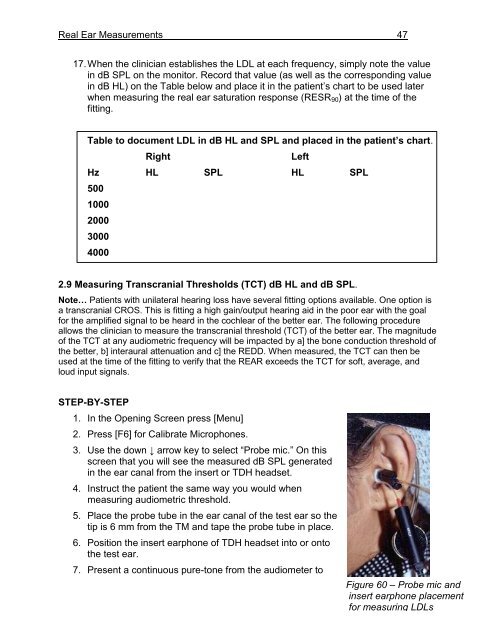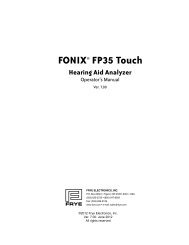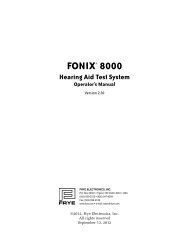Using the FONIX 7000 to Verify Coupler and Real-Ear Performance ...
Using the FONIX 7000 to Verify Coupler and Real-Ear Performance ...
Using the FONIX 7000 to Verify Coupler and Real-Ear Performance ...
You also want an ePaper? Increase the reach of your titles
YUMPU automatically turns print PDFs into web optimized ePapers that Google loves.
<strong>Real</strong> <strong>Ear</strong> Measurements 47<br />
17. When <strong>the</strong> clinician establishes <strong>the</strong> LDL at each frequency, simply note <strong>the</strong> value<br />
in dB SPL on <strong>the</strong> moni<strong>to</strong>r. Record that value (as well as <strong>the</strong> corresponding value<br />
in dB HL) on <strong>the</strong> Table below <strong>and</strong> place it in <strong>the</strong> patient’s chart <strong>to</strong> be used later<br />
when measuring <strong>the</strong> real ear saturation response (RESR90) at <strong>the</strong> time of <strong>the</strong><br />
fitting.<br />
Table <strong>to</strong> document LDL in dB HL <strong>and</strong> SPL <strong>and</strong> placed in <strong>the</strong> patient’s chart.<br />
Right Left<br />
Hz HL SPL HL SPL<br />
500<br />
1000<br />
2000<br />
3000<br />
4000<br />
2.9 Measuring Transcranial Thresholds (TCT) dB HL <strong>and</strong> dB SPL.<br />
Note… Patients with unilateral hearing loss have several fitting options available. One option is<br />
a transcranial CROS. This is fitting a high gain/output hearing aid in <strong>the</strong> poor ear with <strong>the</strong> goal<br />
for <strong>the</strong> amplified signal <strong>to</strong> be heard in <strong>the</strong> cochlear of <strong>the</strong> better ear. The following procedure<br />
allows <strong>the</strong> clinician <strong>to</strong> measure <strong>the</strong> transcranial threshold (TCT) of <strong>the</strong> better ear. The magnitude<br />
of <strong>the</strong> TCT at any audiometric frequency will be impacted by a] <strong>the</strong> bone conduction threshold of<br />
<strong>the</strong> better, b] interaural attenuation <strong>and</strong> c] <strong>the</strong> REDD. When measured, <strong>the</strong> TCT can <strong>the</strong>n be<br />
used at <strong>the</strong> time of <strong>the</strong> fitting <strong>to</strong> verify that <strong>the</strong> REAR exceeds <strong>the</strong> TCT for soft, average, <strong>and</strong><br />
loud input signals.<br />
STEP-BY-STEP<br />
1. In <strong>the</strong> Opening Screen press [Menu]<br />
2. Press [F6] for Calibrate Microphones.<br />
3. Use <strong>the</strong> down ↓ arrow key <strong>to</strong> select “Probe mic.” On this<br />
screen that you will see <strong>the</strong> measured dB SPL generated<br />
in <strong>the</strong> ear canal from <strong>the</strong> insert or TDH headset.<br />
4. Instruct <strong>the</strong> patient <strong>the</strong> same way you would when<br />
measuring audiometric threshold.<br />
5. Place <strong>the</strong> probe tube in <strong>the</strong> ear canal of <strong>the</strong> test ear so <strong>the</strong><br />
tip is 6 mm from <strong>the</strong> TM <strong>and</strong> tape <strong>the</strong> probe tube in place.<br />
6. Position <strong>the</strong> insert earphone of TDH headset in<strong>to</strong> or on<strong>to</strong><br />
<strong>the</strong> test ear.<br />
7. Present a continuous pure-<strong>to</strong>ne from <strong>the</strong> audiometer <strong>to</strong><br />
Figure 60 – Probe mic <strong>and</strong><br />
insert earphone placement<br />
for measuring LDLs
















